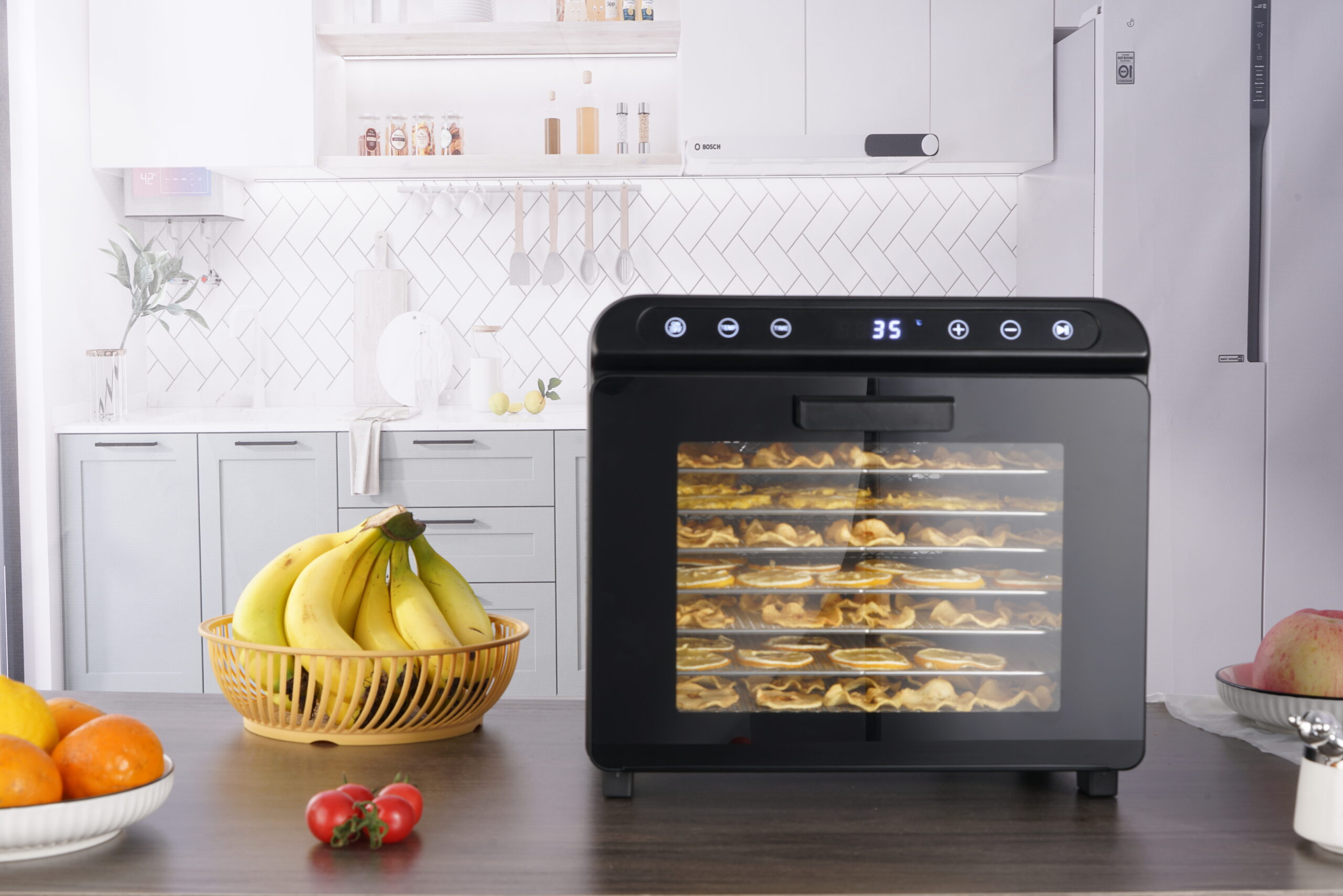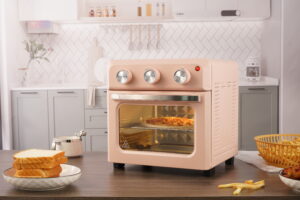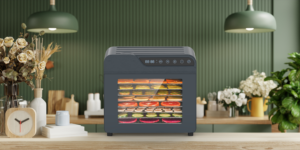As the Sales Manager at Foshan Linden Intelligent Appliances Co., Ltd., I’m thrilled to help eco-conscious home cooks find appliances that save energy while delivering top performance. From our factory in China, we produce high-quality food dehydrators, alongside our 12L, 16L, and 30L air fryer ovens and air fryers, exported to North America, Europe, Russia, and the Middle East. A question I often hear at trade shows and through our website, lindensmart.com, is: Which food dehydrator is the most energy-efficient for preserving fruits? I’m excited to share my expertise and compare food dehydrators to help you choose the most energy-efficient option for your kitchen.
In this article, I’ll explore the energy efficiency of food dehydrators, focusing on their design, features, and performance for fruit preservation. Drawing from our experience at Linden, where we craft innovative appliances with customizable settings, I’ll break down key factors to guide your decision. Let’s dive into the world of energy-efficient food dehydration!
What Are Food Dehydrators?
Food dehydrators are countertop appliances that remove moisture from fruits, vegetables, herbs, and more, extending shelf life. They use a heating element and fan to circulate warm air, preserving flavor and nutrients. According to WebMD, dehydrated fruits retain most vitamins, making them a healthy snack option. Energy efficiency varies based on design, wattage, and features, which we’ll compare to find the best choice.
Why Focus on Energy Efficiency?
I’ve seen buyers prioritize appliances that reduce energy costs and environmental impact. Energy-efficient food dehydrators save money and align with sustainable living, making them ideal for eco-conscious kitchens.
Types of Food Dehydrators
Food dehydrators come in two main designs: horizontal and vertical. Each has unique features affecting energy use, which I’ll explore to help you pick the most efficient model for fruit drying.
Key Factors in Energy Efficiency
Energy efficiency depends on several factors. Let’s examine how these influence the performance of food dehydrators when preserving fruits.
Wattage and Power Consumption
Low-Wattage Dehydrators (200–400W)
Low-wattage models use less electricity, typically 0.2–0.4 kWh per hour, per Energy Star. They’re ideal for small batches of fruit, like drying a few trays of apples or berries. However, lower wattage may mean longer drying times, which can offset energy savings.
Mid-Wattage Dehydrators (400–600W)
Our Linden food dehydrators fall in this range, balancing power and efficiency. They use 0.4–0.6 kWh per hour, drying fruits efficiently without excessive energy draw. For example, our models can dry a batch of mango slices in 6–8 hours, saving energy compared to higher-wattage units.
High-Wattage Dehydrators (600–1000W+)
High-wattage models dry faster but consume more energy, often 0.6–1 kWh per hour. They’re suited for large-scale drying but may not be the most energy-efficient for home use.
Airflow Design
Horizontal Airflow Dehydrators
Our food dehydrators use horizontal airflow, with a fan at the back pushing air across trays. This design ensures even drying, reducing the need for extended run times. Consumer Reports notes that horizontal airflow is more energy-efficient as it eliminates tray rotation, saving power.
Vertical Airflow Dehydrators
Vertical dehydrators have a fan at the top or bottom, pushing air through stacked trays. Uneven drying often requires tray rotation, extending drying times and increasing energy use. This makes them less efficient for fruit preservation.
Temperature Control and Precision
Adjustable Temperature Settings
Our food dehydrators offer adjustable temperatures (90–165°F), allowing precise control for fruits. For example, drying berries at 130°F preserves nutrients while minimizing energy use, as recommended by Healthline. Precise controls prevent over-drying, reducing wasted energy.
Fixed or Limited Temperature Settings
Some dehydrators have fixed or limited temperature settings, which may force higher heat than needed. This can increase energy consumption, especially for delicate fruits like strawberries that require lower temperatures.
Insulation and Build Quality
Well-Insulated Models
Our Linden food dehydrators are built with durable, insulated materials to retain heat. Good insulation reduces energy loss, making drying more efficient. Poorly insulated models lose heat, requiring more power to maintain temperatures.
Basic Insulation
Lower-cost dehydrators often have minimal insulation, leading to higher energy use. This can make them less cost-effective over time, especially for frequent fruit drying.
Comparing Energy Efficiency of Food Dehydrators
Let’s dive into how different food dehydrators stack up for energy efficiency when drying fruits.
Linden’s Food Dehydrators: Mid-Wattage, Horizontal Airflow
Our food dehydrators are designed for efficiency. They use 400–600W, consuming 0.4–0.6 kWh per hour. The horizontal airflow ensures even drying, reducing run times. For example, drying a batch of apple slices takes 6–8 hours, using approximately 2.4–4.8 kWh total. Adjustable temperature settings and insulation further optimize energy use, making our models a top choice for eco-conscious cooks.
Key Features for Efficiency
- Horizontal Airflow: Even drying without tray rotation.
- Adjustable Temperatures: Precise settings for fruits (130–140°F).
- Insulated Build: Minimizes heat loss for lower energy use.
- Digital Controls: Timers prevent over-drying, saving power.
Low-Wattage Vertical Dehydrators
Low-wattage vertical dehydrators (200–400W) use 0.2–0.4 kWh per hour. They’re energy-efficient for small batches but require longer drying times (8–12 hours for fruits). Uneven airflow may necessitate tray rotation, increasing energy use slightly. They’re best for occasional use or small households.
Pros and Cons
- Pros: Low energy consumption, affordable.
- Cons: Longer drying times, uneven results.
High-Wattage Dehydrators
High-wattage models (600–1000W) use 0.6–1 kWh per hour. They dry fruits faster (4–6 hours) but consume more energy, often 3.6–6 kWh per batch. They’re less efficient for home use unless drying large volumes regularly.
Pros and Cons
- Pros: Fast drying, high capacity.
- Cons: Higher energy costs, overkill for small batches.
Practical Applications for Energy-Efficient Fruit Drying
Energy efficiency matters for different drying scenarios. Here’s how food dehydrators perform based on user needs.
Small-Scale Drying: Low-Wattage Models
For small batches, like a few trays of berries, low-wattage vertical dehydrators are efficient. They use minimal power but may take longer, making them ideal for occasional use or small kitchens.
Medium to Large Batches: Our Linden Dehydrators
Our food dehydrators shine for medium to large batches. The horizontal airflow and mid-wattage design dry fruits like apples or mangoes in 6–8 hours, using less energy than high-wattage models. They’re perfect for frequent users or families preserving garden harvests.
Heavy-Duty Drying: High-Wattage Models
For bulk drying, high-wattage dehydrators are faster but less energy-efficient. They suit commercial use or avid preservers but may not be cost-effective for most homes.
Other Factors Impacting Energy Efficiency
Beyond wattage and airflow, other factors influence energy efficiency.
Capacity and Tray Design
Spacious Trays for Efficiency
Our food dehydrators feature spacious, rectangular trays, allowing you to dry more fruit per cycle. This reduces the need for multiple sessions, saving energy. Vertical models with smaller, round trays may require additional cycles, increasing power use.
Stackable Trays
Vertical dehydrators use stackable trays, which are compact but limit capacity. Overloading trays can block airflow, extending drying times and reducing efficiency.
Ease of Use
Smart Features for Efficiency
Our dehydrators have digital timers and thermostats, preventing over-drying. This ensures you use only the energy needed, unlike manual models that may run longer than necessary.
Basic Controls
Basic dehydrators with manual dials may lack precision, leading to energy waste if settings aren’t optimized for fruits.
Durability and Maintenance
Durable, Energy-Saving Build
Our food dehydrators are built to last, with insulated designs that maintain efficiency over time. Durable, food-safe materials and dishwasher-safe trays reduce maintenance effort, ensuring consistent performance.
Basic Models
Lower-cost models may degrade faster, losing insulation efficiency and requiring more energy over time.
Environmental Impact
I’m passionate about sustainability. Energy-efficient food dehydrators reduce your carbon footprint and save money. Our models use less power and produce shelf-stable fruits, eliminating the need for energy-intensive refrigeration, unlike freezing, per Energy Star.
Which Food Dehydrator Is Most Energy-Efficient?
Choosing the most energy-efficient food dehydrator depends on your needs. Here’s how to decide, based on my experience with buyers.
Choose Our Linden Food Dehydrators If You:
- Dry medium to large batches of fruit regularly.
- Want even drying without tray rotation.
- Need precise temperature control for efficiency.
- Value durability and insulated designs.
- Seek a balance of speed and low energy use.
Our horizontal food dehydrators are ideal for eco-conscious cooks, offering efficiency and performance.
Choose Low-Wattage Vertical Dehydrators If You:
- Dry small batches occasionally.
- Have limited kitchen space or budget.
- Don’t mind longer drying times or tray rotation.
- Prioritize minimal power consumption.
Choose High-Wattage Dehydrators If You:
- Dry large volumes frequently.
- Need fast drying for bulk preservation.
- Can accept higher energy costs for speed.
Quality and Reliability
At Linden, quality is non-negotiable. Our food dehydrators meet UL and CE standards, ensuring durability and safety. Their energy-efficient design delivers consistent results, making them a trusted choice for fruit preservation.
Logistics and Customer Support
From my experience with global buyers, logistics are key. Our food dehydrators are lightweight and easy to ship, ensuring timely delivery worldwide. We optimize production for tight schedules. Have questions? I’m here at sales4@fslinden.com to help.
SEO-Friendly Tips for Choosing an Energy-Efficient Dehydrator
To pick the most energy-efficient food dehydrator, here are tips optimized for search terms like “energy-efficient food dehydrators” or “best fruit dehydrators”:
- Check Wattage: Balance power and efficiency for your needs.
- Prioritize Airflow: Choose horizontal models for even drying.
- Look for Insulation: Ensure minimal heat loss.
- Read Reviews: Explore platforms like CNET for insights.
- Test at Trade Shows: Try appliances hands-on for confidence.
Final Thoughts: The Most Energy-Efficient Food Dehydrator
As someone who loves helping eco-conscious cooks, I’m confident our Linden food dehydrators are the most energy-efficient choice for most homes. Their horizontal airflow, mid-wattage design, and precise controls minimize energy use while delivering consistent results. Low-wattage vertical models suit small batches, while high-wattage units are best for bulk drying but use more power. Your choice depends on your drying needs, kitchen space, and sustainability goals.
Ready to preserve fruits efficiently? Visit lindensmart.com to explore our food dehydrators, or email me at sales4@fslinden.com for personalized advice. Let’s make your kitchen eco-friendly and delicious!
Meta Title: Best Energy-Efficient Food Dehydrators for Fruit Drying
Meta Description: Compare food dehydrators for energy efficiency. Discover which model saves power while preserving fruits perfectly.




